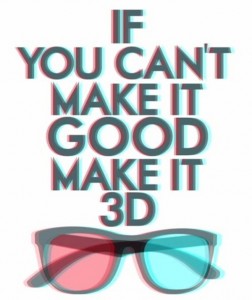If you can’t make it good…
Found on FXRant. Tracing back the source of the image through countless blogs leads to a t-shirt at threadless though.
When movies first came out with audio, did the directors abuse the new technology in the way 3D is employed now? Did they crank up the volume all the way all the time just to prove to the audience that they can make use of “this new thing”? Or are 3D-sceptics like people who decried talkies as “just a fad”? Well, at least there was never a need to wear hearing aids just to enjoy the new technology.
Except for Avatar all current 3D movies use the technology like HTML was (ab)used in the early days of the internet. Make it blink! Make it scroll! Except you didn’t need any special glasses to look at web pages. It’ll take some time until both producers and directors accept 3D as “just another tool” to tell an appealing story. For Alice it was unnecessary in my opinion and turned a good-looking movie with an ok story into an amusement park ride for children.
Right now, given the mass of movies converted to 3D it really seems like studios are treating 3D as a fad and are trying to make some quick bucks by winning back viewers from 2D home cinema and pirated downloads before the hype is fading.
Sure, an audience that flocks Transformers 2 will always flock Transformers 3D (and Titans was a box office hit as well despite the bad ratings and bad 3D). But regular movies in 3D? Where the camera doesn’t move all the time and nothing gets thrown into your face? Letting your eyes wander in a static shot with defocused parts in it destroys the illusion of 3D. Cameron knew how to reduce the depth of those wide panoramic shots in Avatar. But will lesser known directors be able to convince their producers to spend extra millions on 3D just to deliver almost 2D-like shots that suit the cinematography of a slower movie? And will the audience pay for expensive tickets and put on those annoying glasses for that?
Mega Piranha!
I’ll go on record saying that there are far too few movies out there with titles that have “mega” in them. Luckily, as of 2010, there is…. (cue drum roll)
MEGA PIRANHA!
Watch the trailer in all it’s B-movie glory:
Yes, it’s not a spoof. Check IMDB. The effects look like something that came on a free training DVD for After Effects (although the CGI piranhas are not that bad if you put them in perspective…). Reminds me of another great piece of art called “Shark in Venice” which just features stock footage of sharks, lots of continuity mistakes and Stephen Baldwin’s man boobs. Wait a second… He actually was diagnosed with breast cancer according to Wikipedia? I guess that makes that joke a bit tasteless. Oh, and he’s also a hard-core right-wing guy who “threatened to move to Canada if Barack Obama was elected” (source: also Wikipedia)? Life is stranger than fiction.
Anyway, I’m digressing. This is a good opportunity to post a video clip that I had lying around on my hard disk for quite a while. It’s from a SciFi TV movie called “Heatstroke” and it’s exceptional in its goofiness. I think that’s a nice example of misguided CGI. A guy in a rubber suit would at least have given the impression that somebody cared about the movie. I pity the guys who had to work on this beach scene:
Pixels
Short animation by Patrick Jean and the French VFX studio “One More Production“:
The idea is not that new, for example there has been a Röyksopp music video (“Happy Up Here”) featuring space invaders a while ago. But the compositing on “Pixels” is really nice and there are a lot of great ideas from arcade-style start to finish.
(via “No Fat Clips“)
Los Compos
 Auf der Website der spanischen “Etérea Studios” gibt es einen guten Überblick über verschiedene einfache Tricks, um rohe CG-Renderings etwas aufzupeppen. Die Screenshots sind für Photoshop und der Text auf Spanisch, aber dennoch sollte es ein leichtes sein, die Tipps zu verstehen und in Fusion/Nuke/AE umzusetzen.
Auf der Website der spanischen “Etérea Studios” gibt es einen guten Überblick über verschiedene einfache Tricks, um rohe CG-Renderings etwas aufzupeppen. Die Screenshots sind für Photoshop und der Text auf Spanisch, aber dennoch sollte es ein leichtes sein, die Tipps zu verstehen und in Fusion/Nuke/AE umzusetzen.
VFX Branche
Jeder in der Branche kennt wohl die aktuellen Gespräche über den Zustand der (hauptsächlich amerikanischen) VFX-Firmen, die trotz den Milliarden-Box-Office-Umsätzen ihrer Filme letztendlich mangels Gewinn schließen müssen. Der Ruf nach einer Vereinigung oder Gewerkschaft wird laut.
Während man als gemeiner Artist natürlich schnell am Quengeln über Bezahlung, Arbeitsbedingungen und böse Studios ist, würde man natürlich genauso ungern einfach den Wacomgriffel niederlegen und Konsequenzen ziehen. (Sei es der Lust auf den Credit oder einfach der Spaß an der Arbeit geschuldet bzw. der Angst als Freelancer einen schlechten Ruf zu kriegen.) Wo also den Hebel ansetzen ohne gleich die ganze Branche ändern zu müssen, was spätestens beim outsourcing nach Indien oder Osteuropa schnell eine weltweite Übereinkunft erfordert?
Scott Squires auf Effects Corner hat einen guten Artikel geschrieben, der erstmal die Grundproblematik von VFX in einer Filmproduktion untersucht: Effekte werden als “externe Dienstleistung” zum Fixpreis verkauft, obwohl sie erstens absolute Maßanfertigung oder sogar technisches und kreatives Neuland sind, zweitens die VFX-Szenen eine im Vergleich zu Realdrehs unglaubliche Menge an Änderungen/Revisionen erfahren, drittens zum Zeitpunkt des Biddings der endgültige Umfang der nötigen VFX-Arbeiten nicht klar ist und viertens die Deadline dann nicht von Seiten der VFX sondern von Seiten der Produktion gesetzt wird.
So kann man in keinem anderen Bereich mit Menschen umgehen, die einem Maßanfertigungen machen (Anzüge, Autos, Häuser…). Lesenswert.
Ich glaube die Lösung wird nur eine win-win-Situation sein können, bei denen die Seite die das Geld ausgibt (also die Studios) merken, dass sie bessere Qualität zum selben Preis bekommen können (Gewerkschaftsauflagen werden sofern sie sich nur auf den Preis auswirken immer unterlaufen werden in einer so schnellen und internationalen Branche). Beispielsweise, wenn die VFX wieder direkt für die Produktion (und sogar auf deren Gelände) arbeitet statt für Firmen die einen personellen Overhead sowie Auftragslöcher finanzieren müssen. Ein schnelles Auf- und Abbauen einer Produktionspipeline wäre dann von Nöten, aber wenn man sieht, wie jede Firma im laufenden Betrieb über Jahre ihre eigene Pipeline zusammenschustert…
Hier wäre eine komplette Open-Source-VFX-Pipeline-Software willkommen, die zumindest das Spielfeld für kleinere Teams glättet, die dann so schnell losstarten können wie man sonst eben die Renderkisten bestellt und anstöpselt (dass das dann nicht für Avatar genügt ist klar). Nur bislang hütet jede Firma ihre Scripte (zu Recht) als Wettbewerbsvorteil bzw. veröffentlicht nur Bruchstücke, die andere wiederum mit viel Klebeband in ihre Pipeline integrieren müssen. Wieviel tausend mal allein in Deutschland das Rad neu erfunden wurde, weil verschiedene Softwareprodukte unter eine Decke gebracht werden sollten oder erstmal die eklatanten Schwächen des Windows-Explorers bei der versionierten Verwaltung von Einzelbildsequenzen umgangen werden mussten…
Oder wäre das nur mal wieder der Versuch, Symptome technisch zu lösen statt an die Wurzel zu packen? Food for thought…
Algorithms
Adobe demonstrates a future Photoshop feature called “Content-Aware Fill” that is the healing brush on crack. It’ll “extrapolate” image patterns to remove unwanted elements or extend landscapes.
Looks pretty amazing in this youtube video:
It’s probably based on some Siggraph paper. For example, the content-aware-resizing that Photoshop has since CS4 was also demoed at Siggraph first:
The algorithms that are currently developed in this field are simply amazing. Here’s the one that will put me out of work in a few years: automatic image composition based on a simple doodle:
Sketch2Photo: Internet Image Montage from Tao Chen on Vimeo.
Or this one on image stabilisation:
And finally this all-time favourite from 2007 (!) that apparently still hasn’t made it into a commercial product: An algorithm that seamlessly inserts high-resolution photos into a low-resolution video. Or removes unwanted elements. Or removes reflections. Or seamlessly changes what was behind those reflections.
Using Photographs to Enhance Videos of a Static Scene from pro on Vimeo.
Tilt/Shift
Sometimes an advertising idea is pure genius. The kind of “that’s so cool and easy, why didn’t anybody think of this before?”. Like this German telecom commercial with a tilt/shift lens.
And then you find out that indeed somebody thought about it first and that the ad is at worst a rip-off and at best a commissioned piece of work. But pretty to look at nevertheless!
Here’s a piece of an Australian photographer who utilized that look on a number of clips:
